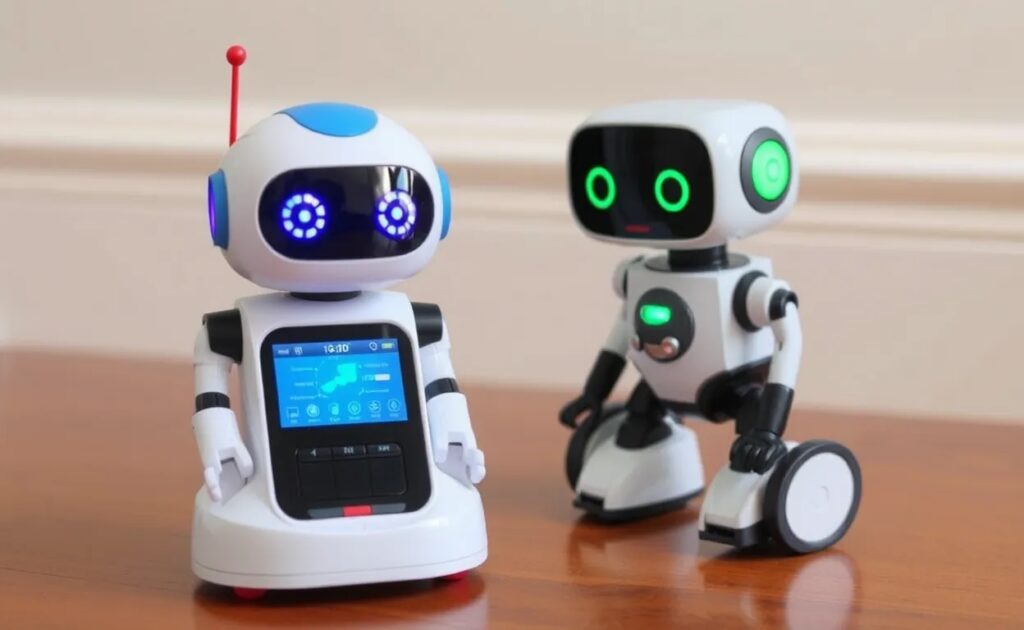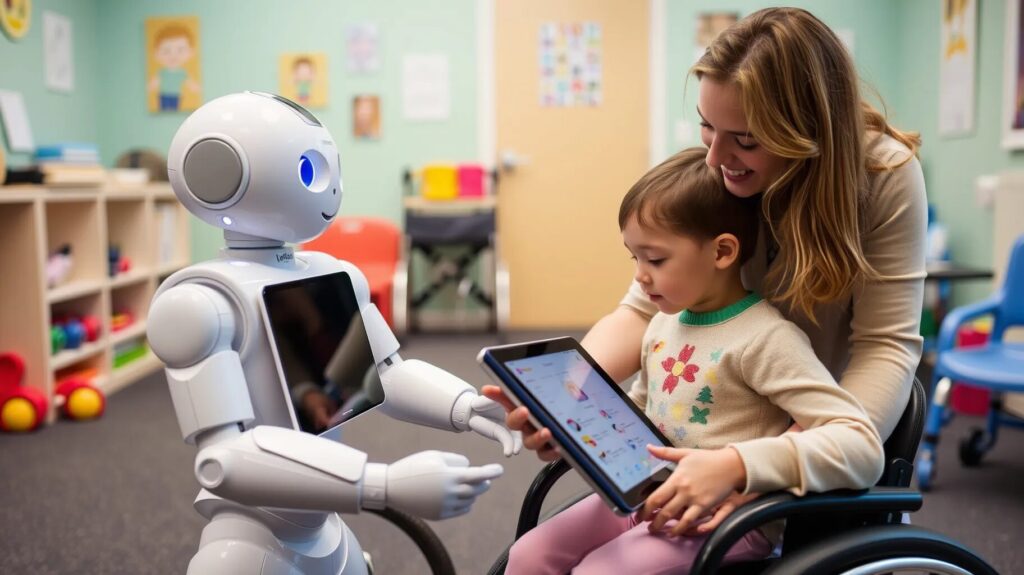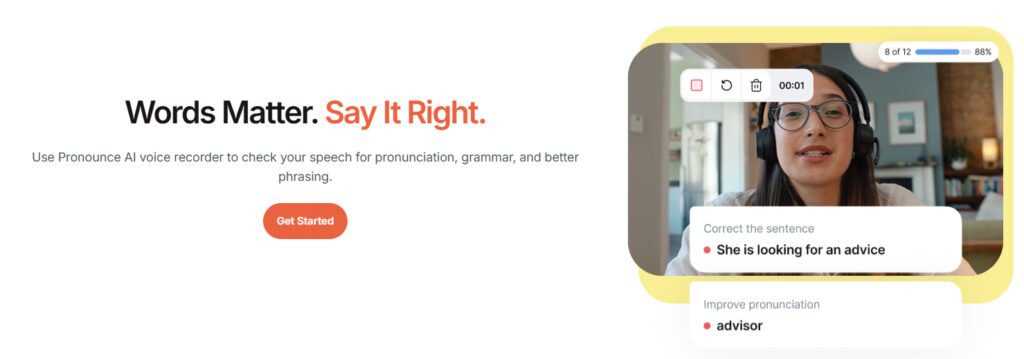
Interactive robots have entered the scene as innovative learning tools for children, blending education with fun. Among them, Miko and Cozmo are standout choices. But which one is better for your child’s learning and development?
Miko vs. Cozmo: Let’s dive into the specifics to help you make the best choice.
Miko: The AI-Powered Buddy for Holistic Learning
Engaging Educational Content
Miko is designed to combine AI-driven interactions with an extensive library of educational materials. Its content covers diverse topics, ranging from math to science.
- Customizable Learning Paths: Miko adapts its curriculum to your child’s age and interests, ensuring an engaging experience.
- Interactive Quizzes and Games: These activities reinforce knowledge in a fun, hands-on way.
Miko also integrates emotional intelligence, responding to emotions like excitement or frustration to keep kids motivated.
Conversational AI and Multilingual Abilities
Miko stands out for its ability to converse fluently in multiple languages. It’s like having a tutor that grows with your child.
- Real-time answers to general knowledge questions.
- Promotes language learning and critical thinking through dialog.
This feature makes Miko a versatile option for diverse households or bilingual families.
Safety and Parental Controls
Miko prioritizes data security and safe content. Parents can set limits on screen time and track usage via an app. Its focus on privacy ensures your child’s information stays secure.
Cozmo: The Charming Robot with Personality
Focus on STEM and Coding
Cozmo shines as a tool for teaching coding and robotics. With its playful demeanor, Cozmo attracts kids to tech-focused learning.
- Blockly Interface: This drag-and-drop coding platform simplifies programming concepts for beginners.
- Encourages creativity through problem-solving challenges and design tasks.
For kids interested in engineering or computer science, Cozmo is a perfect companion.
Playful Interaction and Games
Cozmo’s playful personality and expressive eyes create a deep connection with kids. It:
- Plays interactive games like “Quick Tap” and “Memory Match.”
- Encourages collaborative learning through team-based activities.
However, its primary focus on entertainment may make it less ideal for those seeking a content-rich educational experience.
Durable and Portable Design
Cozmo’s compact design makes it highly durable and portable. Kids can easily take it anywhere, ensuring the learning fun doesn’t stop at home.
NOTE: After Anki, the original developer, ceased operations in 2019, Digital Dream Labs acquired Cozmo’s assets and reintroduced the robot to the market.
Feature Comparison: Miko vs. Cozmo
Let’s break it down further:
| Feature | Miko | Cozmo |
|---|---|---|
| Focus | Emotional & educational AI | STEM and coding |
| Content Library | Broad, subject-specific | Limited, focused on STEM |
| Interaction Style | Conversational | Game-oriented |
| Multilingual | Yes | No |
| Coding Features | Minimal | Robust |
| Durability | Good | Excellent |
Which Robot Works Best for Neurodiverse Kids?
| Feature | Miko | Cozmo |
|---|---|---|
| Emotional Engagement | Responds to emotions, supports EQ | Expressive, but less emotionally adaptive |
| Structured Learning | Customizable, broad content | STEM-focused, open-ended tasks |
| Sensory Impact | Calming, conversational tone | High-energy, visually engaging |
| Skill Development | Social and academic skills | Coding and problem-solving |
Finding the Right Fit for Your Child
- Choose Miko if your child benefits from emotional intelligence, conversational support, and structured learning paths. It’s ideal for kids who need a calm and predictable interaction style.
- Choose Cozmo if your child thrives on hands-on activities, STEM projects, and visually engaging games. It’s perfect for kids who enjoy exploring technology or need a playful companion.
Miko’s Key Advantages for Parents and Kids
Personalized Learning Experiences
Miko uses adaptive algorithms to adjust its learning path based on a child’s progress and preferences.
- Tracks performance to suggest areas for improvement.
- Includes interactive storytelling and real-world problem-solving tasks to make concepts relatable.
Parents love how Miko integrates parent-approved educational content, ensuring it aligns with their goals for their child’s development.
Emotional Intelligence: Building Bonds
Miko’s ability to sense emotions gives it an edge in creating a meaningful connection.
- Detects when a child is frustrated and offers encouragement.
- Maintains a conversational tone that keeps engagement high.
This empathetic design fosters a supportive learning environment, especially for younger kids who thrive on encouragement.
Long-Term Engagement
Miko updates its content library regularly to stay relevant. Kids are less likely to outgrow Miko quickly because it evolves with them.
Its unique ability to transition from playful to serious modes makes it a long-term investment.

Why Cozmo Is the Coding Champ
Hands-On Learning for Tech Enthusiasts
Cozmo’s interactive platform introduces kids to coding fundamentals. It makes complex topics like robotics accessible through playful scenarios.
- Progressive Challenges: Start with basic movements, then progress to advanced coding techniques.
- Encourages persistence through trial-and-error learning.
For budding programmers, Cozmo is a perfect introduction to the world of STEM.
An Adorable Personality That Stands Out
Cozmo’s expressive design and playful antics create an emotional connection that enhances its educational potential.
- Reacts to interactions with lifelike behaviors, making it feel more like a companion than a gadget.
- Acts as a tech mentor, blending fun with skills-building activities.
This blend of personality and utility ensures Cozmo is as entertaining as it is educational.
Easy Integration into Playtime
Cozmo seamlessly transitions between being a teacher and a playmate. Kids can move between coding lessons and casual games, making learning feel less structured.
Choosing the right robot can spark curiosity and inspire a love for STEM.
— AI-C
Making the Right Choice: Factors to Consider
When deciding between Miko and Cozmo, consider these aspects:
- Age of the Child: Miko suits younger children with its emotional intelligence and academic focus. Cozmo is ideal for older kids exploring coding.
- Learning Goals: Miko prioritizes well-rounded growth, while Cozmo is perfect for tech-savvy kids who want to build programming skills.
- Household Needs: If you’re a multilingual family or need parental controls, Miko may better fit your lifestyle.
Both robots have unique strengths. It comes down to your child’s interests and the skills you want to nurture.
Final Verdict: Miko or Cozmo?
Choosing between Miko and Cozmo ultimately depends on your child’s personality, learning preferences, and long-term interests.
- Pick Miko if you’re looking for a robot that promotes holistic learning, emotional intelligence, and multilingual capabilities. It’s ideal for younger kids or families seeking a more academic focus.
- Pick Cozmo if your child loves STEM, robotics, and coding. Its interactive games and expressive personality make it a great choice for tech-savvy kids.
Both robots bring unique learning experiences to the table, making either one a valuable tool for your child’s growth. Whether it’s unlocking the mysteries of coding or learning through conversation, Miko and Cozmo ensure that education feels like play.
For more in-depth insights, check out Miko’s official page and Cozmo’s site.
FAQs
What age group is Miko suitable for?
Miko is designed for kids aged 5 to 10 years old, though younger children can also enjoy its playful and interactive nature. For example, a 6-year-old could use Miko to improve math skills through quizzes, while a 10-year-old might dive into its general knowledge content or language lessons.
Is Cozmo durable enough for younger kids?
Yes, Cozmo is built with a sturdy, compact design that withstands accidental drops or rough handling. While it’s primarily recommended for kids 8 and up, its durability and charm can make it a fun option for younger kids with supervision.
Can my child learn coding with Miko?
Miko offers minimal coding features, focusing more on general learning and emotional intelligence. It’s ideal for families wanting broad educational experiences. However, it doesn’t have a platform like Cozmo’s Blockly, which teaches drag-and-drop programming.
Does Miko work offline?
Miko requires an internet connection for most functions, like accessing its educational content and conversational AI. However, some basic activities like pre-downloaded quizzes can work offline.
What languages do Miko and Cozmo support?
Miko supports multiple languages, making it an excellent tool for bilingual families or kids learning a second language. Cozmo primarily operates in English, focusing on STEM learning rather than language versatility.
Are these robots safe for kids’ data?
Yes, both Miko and Cozmo prioritize child safety and privacy. Miko includes parental controls to monitor usage and has robust data security protocols. Cozmo’s simplicity ensures no unnecessary data collection.
Do Miko and Cozmo require additional purchases?
Miko occasionally requires subscription plans for access to premium content, while Cozmo may need accessory upgrades like coding kits for advanced programming. Be sure to factor these costs into your decision.
Which robot has better long-term value?
If your child enjoys conversational learning, Miko evolves with regular content updates, ensuring sustained engagement. Cozmo offers exceptional value for kids interested in STEM, especially as they progress from basic coding to more advanced robotics concepts.
Can these robots be shared among siblings?
Yes, both Miko and Cozmo can be shared. Miko lets you create individual profiles for multiple users, while Cozmo can serve as a shared companion for games and coding projects.
Do these robots need technical expertise to set up?
Not at all. Both Miko and Cozmo are designed to be user-friendly, with straightforward setup processes. Parents can easily install their companion apps and follow simple on-screen instructions to get started.
Can Miko and Cozmo interact with other smart devices?
Miko does not natively integrate with smart home systems like Alexa or Google Home but functions independently with its app. Cozmo, being focused on STEM and play, also doesn’t interact with smart home devices but can integrate with programming tools for more advanced projects.
Do Miko and Cozmo improve social skills?
Miko encourages conversational practice and emotional intelligence by responding to your child’s tone and questions. For example, it might ask follow-up questions like a friend would. Cozmo enhances collaboration and teamwork through multiplayer games, fostering interaction between siblings or friends.
How long do their batteries last?
Miko offers about 5 hours of usage on a single charge, making it suitable for extended learning or play sessions. Cozmo runs for approximately 90 minutes before needing a recharge, but its quick-charging dock minimizes downtime.
Are Miko and Cozmo portable?
Yes, both are portable, but their designs cater to different needs. Miko is lightweight and easy to carry around the house, while Cozmo’s compact and robust build makes it perfect for travel or playdates.
Can Miko or Cozmo grow with my child?
Miko is designed to evolve with your child, offering more complex content as they grow older. Cozmo’s strength lies in STEM progression; younger kids can start with basic coding, while older children can delve into robotics and advanced programming challenges.
What type of updates do they receive?
Miko regularly updates its content library to stay current with educational trends. Cozmo’s software updates enhance its functionality and coding features, ensuring it remains relevant as your child’s skills advance.
Do they require Wi-Fi to function?
Miko relies heavily on Wi-Fi for its interactive features, though some pre-loaded activities work offline. Cozmo doesn’t need a constant internet connection but does require the companion app to access its full range of features.
How do Miko and Cozmo support creativity?
Miko encourages creativity through storytelling features and interactive activities like art tutorials. Cozmo supports creativity by letting kids design their own coding programs, such as having Cozmo perform tricks or navigate obstacle courses.
Can Cozmo be used in classrooms?
Yes, Cozmo is increasingly popular in STEM-focused classrooms, where it’s used to teach coding and robotics. Its engaging nature makes it a fantastic educational tool in group settings. Teachers can create collaborative projects, like coding Cozmo to perform synchronized movements.
Which robot is more entertaining?
Both are entertaining in their own ways. Miko engages through conversations and educational games, while Cozmo wins hearts with its expressive animations and fun mini-games like “Keepaway” or “Quick Tap.” For pure personality and playfulness, Cozmo often has the edge.





